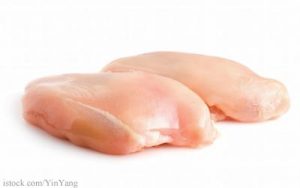The recall of Foster Farms chicken products for Salmonella contaminated has been updated to “clarify and correct” the use or freeze by and best by date ranges. The government is also adding an updated product list. At the same time, the USDA says the recall is not expanded. These products are associated with a huge Salmonella outbreak that has sickened at least 621 people in the U.S.
The recalled product is fresh and frozen chicken sold under Foster Farms or private label brand names with “use or freeze by” dates ranging from March 16 through March 31, 2014, and August 29, 2015 through September 2, 2015. Also recalled are frozen Sunland Chicken products with “best by” dates from March 7 through March 11, 2014 and August 29 2015 through September 2, 2015. Consumers will only be able to locate the dates on fresh product retail packaging. The products bear the establishment numbers “P6137”, “P6137A” or “P7632” inside the USDA mark of inspection.
 The chicken was produced from March 7 through March 13, 2014. The products were shipped to Costco, Foodmaxx, Kroger, Safeway and other retail stores and distribution centers in Alaska, Arizona, California, Hawaii, Idaho, Kansas, Nevada, Oklahoma, Oregon, Utah and Washington. You can see the full list of recalled products at the USDA web site.
The chicken was produced from March 7 through March 13, 2014. The products were shipped to Costco, Foodmaxx, Kroger, Safeway and other retail stores and distribution centers in Alaska, Arizona, California, Hawaii, Idaho, Kansas, Nevada, Oklahoma, Oregon, Utah and Washington. You can see the full list of recalled products at the USDA web site.
The extensive list includes drumsticks, wings, livers, thighs, breasts, chicken tenders, gizzards, hearts, Saddlepack wings, breast steaks, and specialty and seasoned products. The “sell by” date has passed for these products, but they are most likely still in consumer’s freezers. If you have any of these products in your home, discard in a closed container or return to the place of purchase. Remember to thoroughly wash your hands and any contact surfaces with warm soapy water after handling the product.
The USDA and CDC state that there is a link between boneless, skinless chicken breast products from Foster Farms and the Salmonella Heidelberg outbreak. The USDA adds that “Evidence that is required for a recall includes obtaining case-patient product that tests positive for the same particular strain of Salmonella that caused the illness, packaging on product that clearly links the product to a specific facility and a specific production date, and records documenting the shipment and distribution of the product from purchase point of the case-patient to the originating facility.”
The symptoms of a Salmonella infection include diarrhea, abdominal cramps, fever, and nausea within 12 to 72 hours after eating contaminated food. The illness lasts up to a week. Most people recover without treatment, but some must be hospitalized. The hospitalization rate in this outbreak is almost 40%, double the usual number, most likely because four of the seven outbreak strains of Salmonella are antibiotic resistant. If you ate this product and were sick, see your doctor as soon as possible. The long term risks of a Salmonella infection can include meningitis, Reiter’s syndrome, and urinary tract infections.




